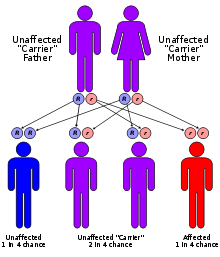- Microvillous inclusion disease
-
Microvillous inclusion disease Classification and external resources OMIM 251850 DiseasesDB 32409 eMedicine ped/461 Microvillous inclusion disease, also known as Davidson's disease, congenital microvillous atrophy and, less specifically, microvillous atrophy, is a rare genetic disorder of the small intestine that is inherited in an autosomal recessive pattern.[1][2]
Contents
Presentation
It is characterized by chronic, intractable diarrhea in new-born infants, starting in the first few days of life.[3] This results in metabolic acidosis and severe dehydration. Pregnancy and birth are usually normal.
Prognosis
It is nearly always fatal unless, like short bowel syndrome patients, treated with parenteral nutrition or an intestinal transplant.[3] The patient is often classified as being in "intestinal failure" and treated with the cohort of patients known as "short bowel syndrome" patients.
Pathophysiology
It is caused by a congenital lack of apical microvilli in the epithelial cells of the small intestine.[4]
Diagnosis
Diagnosis in utero is currently not possible as the gene(s) involved in the disease was only recently discovered to be MYO5B;[5][6] diagnosis is made by biopsy of the small intestine.[1]
Biopsy
The appearance of microvillous inclusion disease on light microscopy is similar to celiac sprue; however, it usually lacks the intraepithelial lymphocytic infiltration characteristic of celiac sprue and stains positive for carcinoembryonic antigen (CEA).[2] The definitive diagnosis is dependent on electron microscopy.[7]
Differential diagnosis
The differential diagnosis of chronic and intractable diarrhea is:[8]
- Intestinal epithelial dysplasia
- Syndromatic diarrhea
- Immunoinflammatory enteropathy
Genetic prevalence
Microvillous inclusion disease is thought to be extremely rare; only, approximately, two dozen cases have been identified in the medical literature.[9]
One patient, a teenage female living in Arizona, suddenly began to grow microvilli after thirteen years of TPN (Total Parenteral Nutrition) and Lipid dependancy. She now enjoys a typical teenage diet and is seen regularly by her Gastroenterologist.
One patient from the UK was documented to achieve nutritional independence at age 3.[10]
One patient from the Netherlands was documented to be sustained by enteral nutrition rather than parenteral nutrition, but did not appear to have any MYO5B mutations.[5]
On 26 June 2009 a six year old girl diagnosed with microvillous inclusion disease became the third person in the UK to die of swine flu.[11]
History
Microvillous inclusion disease was first described in 1978 by Davidson et al.[12] It was originally described as familial enteropathy.
References
- ^ a b Chehade, Mirna; Sicherer, Scott H (2005). "Infantile food protein-induced enterocolitis syndrome". In David, Timothy J. Recent Advances in Paediatrics 22. London: Royal Society of Medicine Press. pp. 140. ISBN 1853155721. http://books.google.com/?id=gyujuv2pOhcC&pg=PA140&vq=%22microvillous+atrophy%22&dq=%22microvillous+atrophy%22
- ^ a b Mills SE, Carter D, Greenson JK, Oberman HA, Reuter V, Stoler MH. Sternberg's Diagnostic Surgical Pathology. 4th Ed. Lippincott Williams & Wilkins. Copyright 2004. ISBN 978-0-7817-4051-7.
- ^ a b Salvatore, S.; Hauser, B.; Vandenplas, Y. (2007). "Chronic enteropathy and feeding". In Cooke, Richard J.; Vandenplas, Yvan; Wahn, Ulrich. Nutrition Support for Infants and Children at Risk. Basel, Switzerland; New York: Karger. pp. 123. ISBN 3805581947. http://books.google.com/?id=5TxMbNABKOAC&pg=PA123&vq=%22microvillous+inclusion+disease&dq=%22microvillous+inclusion+disease%22
- ^ Arpin, M.; Crepaldi, T.; Louvard, D. (1999). "Cross-talk between Apical and Basolateral Domains of Epithelial Cells Regulates Microvillus Assembly". In Birchmeier, Walter; Birchmeier, Carmen. Epithelial Morphogenesis in Development and Disease. Amsterdam: Harwood Academic. pp. 104. ISBN 9057024195. http://books.google.com/?id=gemrGZ596Q8C&pg=PA104&vq=%22microvillous+atrophy%22&dq=%22microvillous+atrophy%22
- ^ a b Mueller T; Hess, MW; Schiefermeier, N; Pfaller, K; Ebner, HL; Heinz-Erian, P; Ponstingl, H; Partsch, J et al. (2008). "MYO5B mutations cause microvillus inclusion disease and disrupt epithelial cell polarity". Nat Genet 40 (10): 1163–5. doi:10.1038/ng.225. PMID 18724368.
- ^ Szperl A, Golachowska M, Rings E, IJzendoorn S, et al (2011). "Functional characterization of mutations in the myosin Vb gene associated with microvillus inclusion disease". J Ped Gastroenterol Nutr 52: 307–13. PMID 21206382.
- ^ Kennea N, Norbury R, Anderson G, Tekay A (2001). "Congenital microvillous inclusion disease presenting as antenatal bowel obstruction". Ultrasound Obstet Gynecol 17 (2): 172–4. doi:10.1046/j.1469-0705.2001.00211.x. PMID 11251929.
- ^ Ruemmele FM (2007). "Chronic enteropathy: molecular basis". Nestle Nutr Workshop Ser Pediatr Program 59: 73–85; discussion 85–8. doi:10.1159/000098514. PMID 17245092.
- ^ Online 'Mendelian Inheritance in Man' (OMIM) Microvillous atrophy -251850
- ^ Croft NM; Howatson, AG; Ling, SC; Nairn, L; Evans, TJ; Weaver, LT (2000). "Microvillous inclusion disease: An evolving Condition". J Pediatr Gastroenterol Nutr 32 (2): 185–189. PMID 10941974.
- ^ "Swine flu girl 'had tough life'". BBC News. 30 June 2009. http://news.bbc.co.uk/1/hi/england/west_midlands/8126095.stm. Retrieved 12 May 2010.
- ^ Davidson GP, Cutz E, Hamilton JR, Gall DG (1978). "Familial enteropathy: a syndrome of protracted diarrhea from birth, failure to thrive, and hypoplastic villus atrophy". Gastroenterology 75 (5): 783–90. PMID 100367.
External links
Categories:- GI tract disorders
- Autosomal recessive disorders
- Pediatrics
- Rare diseases
- Medicine stubs
Wikimedia Foundation. 2010.

